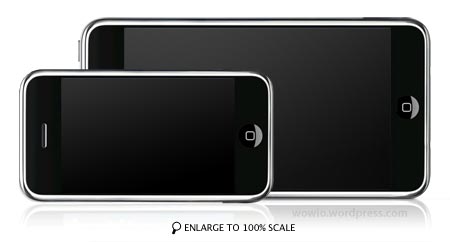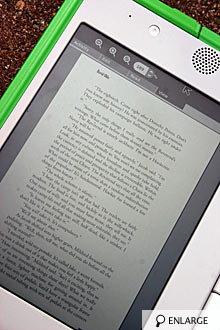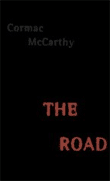
The iPhone and a 5.25″ iTablet, to scale.
Interest in the hypothetical Apple iSlate or iTablet — the hybridized descendant of the iPhone/iPod Touch, the Mac and the Newton— never seems to die, as new (or recycled) rumors swirl with the approach of every Apple-sponsored gathering. The iPhone/Touch branch of the Apple family tree is beginning to unfold with new models and a true third-party development environment, so most of the foundations for a multitouch-enabled tablet device are already laid down. Yet, the machine remains forever on the horizon, a mere glimmer in every Apple fan’s eye. Perhaps — as Apple competitors have discovered — the matter of making such a machine usable and polished to Apple standards is far more than a simple supersizing of what already exists. Given what we know about existing machines, it’s instructive to look at what the iTablet/iSlate might be, along with some of the substantial interface issues that Apple will need to solve before such a machine can become reality.
Look, Touch and Feel

The iTablet, based on a rendering posted at TechEBlog.
The iTablet will likely follow the evolving design themes emerging from Cupertino, continuing the convergence toward aluminum and black that characterize recent Apple machines. The critical acclaim and hotcakes-like acceptance of the MacBook Air guarantees that slimness and lightness will be a priority, and by their omission, optical drives will be given another small push toward obsolescence.
The mockups shown here are beautiful, but I think they’re wrong in at least one other key respect — a touch- and stylus-enabled tablet from Apple would be running a scaled-up variant of the iPhone multitouch interface (Mobile OS X) rather than a scaled-down version of Mac OS X. This avoids the problems that Windows has on Tablet PCs, where traditional Windows interface elements designed for precise mouse control are pressed into service for use with the highly-imprecise fingertip (or somewhat better stylus). Instead, the iTablet would have a new version of the slick iPhone OS X that’s specifically designed for touch input. Controls are sized larger and tasks are logically set up for touch interactions. Gestures for navigation and zooming are fully integrated and intuitive. A pressure-sensitive, Wacom-type stylus might be included as an additional input device, for the artists and graphic designers who would be a key (read “drooling at the thought”) market for such a machine.
If Mobile OS X is indeed used, it opens the question of how more-computer-like tasks will be handled. The larger and more capable form factor implies more complex usage scenarios such as editing between multiple documents, and with it comes an increased expectation or desire to do more than one thing at a time. In the iPhone’s paradigm, very few apps are allowed to multitask in the background and, from a user’s perspective, a single task takes over the entire machine at any given moment. Apple will need to figure out a new method for task switching, while still balancing against the device’s more limited battery and cpu resources. Further, Mobile OS X has no user-accessible equivalent to the Mac Finder to manipulate files. While it’s very possible that Apple will choose to keep it that way, a new paradigm for transferring user files onto the system and allowing access within appropriate apps will still need to defined and integrated into the user interface. The searchable hierarchical lists used in the iPhone’s iTunes Store or the Mac’s Spotlight search app may point the way to how this might work, but much remains to be done.
Screens, Pixels and Thumbs
In my earlier specifications for an ideal ebook reader, I thought that a 12″ display would be ideal. Now, after using a 12″ Lenovo X61T Tablet PC, a 6″ Sony Reader and a 3.5″ iPhone, I’ve changed my mind. The high pixel density and high contrast of the iPhone’s display allows for good readability at reduced text sizes, and the weight and battery life penalties suffered by the Tablet PC make a smaller screen even more attractive. At four pounds, the the X61T gets to be uncomfortable while reading in bed, for example. A high-pixel-density 5.25″ display — as conjectured by the rumor sites — would provide very usable screen real estate without unduly compromising portability or power consumption.
Screen size has other significant implications for the iTablet’s user interface. The virtual keyboard would have room for larger and more widely spaced keys than on an iPhone, but their size and positioning are constrained by the physical reach of the user’s thumbs if the keyboard is to be used in a two-handed, iPhone-style landscape typing position. The bigger the screen, the more necessary it becomes for Apple to develop a smart solution distinct from the simple layout used in the iPhone. Larger screens also open up the possibility of typing on the screen while it rests in landscape mode on a flat surface, more like a traditional (albeit shrunken) computer keyboard than a Blackberry. This usage implies yet another keyboard layout, and Apple would then need to make the machine clever enough to display the right one at the right time. Sensors could detect this orientation similar to the way they currently detect rotation and face proximity — doable, but clearly requiring yet more development.
Suite Apps
Macs, iPhones and iPods all ship with complete suites of applications that allow the machines to perform the functions that they were designed for, all while showing off the machine’s capabilities. By virtue of its screen size, the iTablet is inherently better suited for reading and editing longer documents (like ebooks) than the iPhone. The latter’s smaller screen is not as well suited for this purpose, and the resulting compromised user experience is probably one reason why Apple has not made reader software a priority to this point. In contrast, the iTablet will be a very able platform for ebook reading, and it’s virtually certain that Apple will create an app to show off this strength. Similarly, a stylus-enabled iTablet would make a beautiful handwriting notebook and sketch pad, and it seems very possible that Apple will create a simple app to show off this functionality.
If Not Now, Then When?
That’s the big question. Nearly a year has passed since the iPhone’s debut, and a second generation phone is already expected this year. On the other hand, the issues sampled here suggest that an iTablet is far more than a physical upscaling of the iPhone. Many incremental but still substantial additions and adaptations are needed, and getting it right takes time.
Related Posts
iPhone and eBooks: an Early Flirtation
iPhone and eBooks: the Video
iPhone and iPod: Dense Pixels, Happy Eyes
eBook Reader Technology Scorecard
iPhone Reader: The Long Sessions























